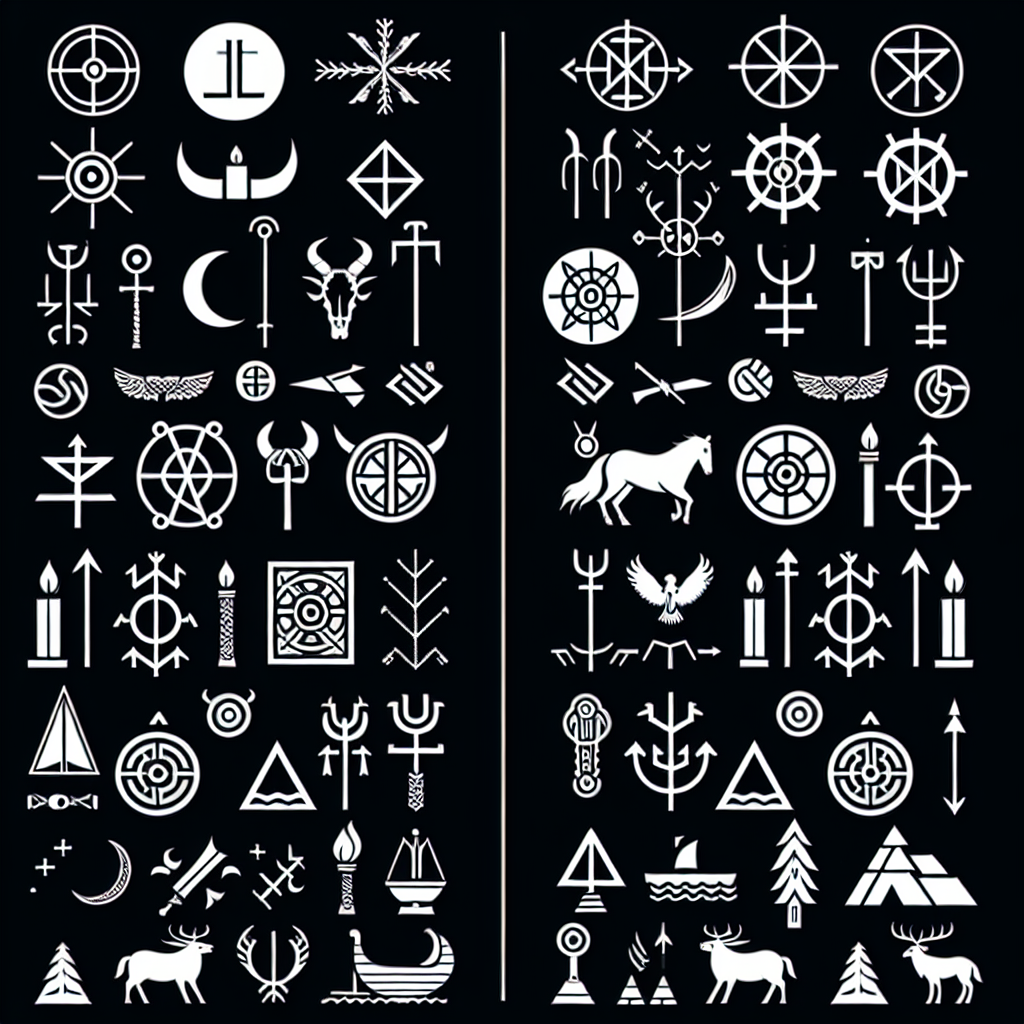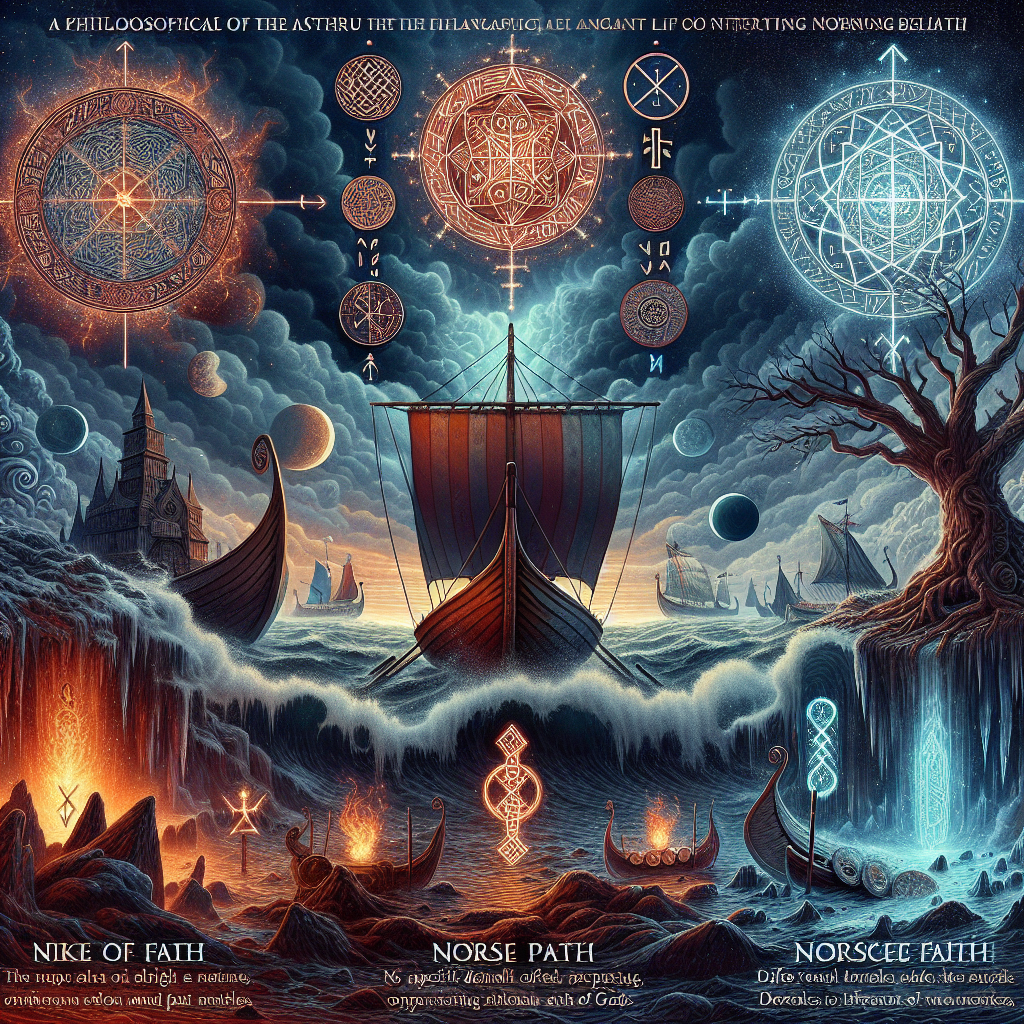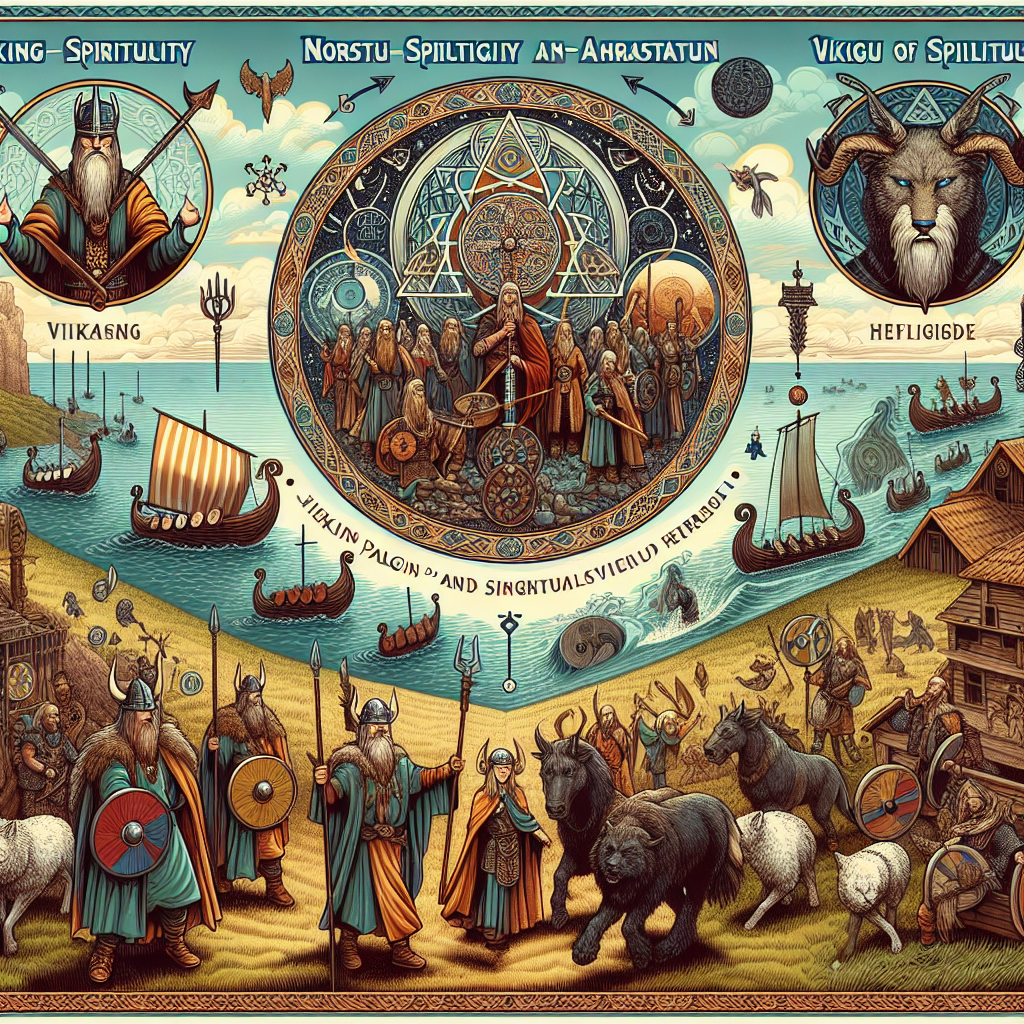As an Amazon Associate I earn from qualifying purchases.

An Insight into Norse Paganism and Asatru
Historical Background
Norse Paganism and Asatru are often used interchangeably, but they hold distinct differences. Norse Paganism is a broad term referring to the various religious practices of the Norse people before the Christianization of Scandinavia. Asatru, on the other hand, is a modern revival of these ancient traditions, emphasizing worship of the Aesir and Vanir gods within the context of contemporary culture. This resurgence reflects a growing interest in reconnecting with pre-Christian spiritualities.
Theological Differences
Theology in Norse Paganism covers a wide array of beliefs and deities, reflecting the regional and tribal variations of ancient Norse societies. Asatru, however, tends to focus more specifically on the Aesir gods, such as Odin and Thor, while maintaining a structure that suits modern practitioners. Norse Paganism does not have a centralized doctrine, resulting in diverse interpretations and practices. Asatru provides a more structured belief system with established rituals and ethical guidelines.
Cultural Practices and Rituals
Cultural practices in Norse Paganism were largely dependent on local customs and could vary significantly from one community to another. These practices included a variety of seasonal festivals, ancestor veneration, and rites of passage. Asatru has attempted to standardize some of these practices, making them more accessible to modern followers. Blóts and Sumbels, for instance, have been adapted into regular ceremonial observances within Asatru communities, providing a sense of continuity and shared experience.
Community and Organization
Norse Paganism did not have a formalized clergy or hierarchical structure, relying instead on the oral transmission of knowledge and community-led rituals. Modern Asatru has established organized groups and legal entities such as the Asatruarfelagid in Iceland, and various Asatru organizations in the United States and Europe. These organizations often provide resources, community support, and legal recognition for believers, fostering a cohesive community that bridges the ancient and modern worlds.
Representation in Modern Culture
The representation of Norse Paganism in modern culture often leans on mythological and historical narratives, perpetuated through media such as film, literature, and video games. Asatru, while drawing from these same sources, strives to present a more accurate representation of the Norse spiritual tradition, differentiating contemporary religious practice from mythologized accounts. This representation has influenced the rising interest in Asatru, with statistics showing an increase in registered followers in recent years, particularly in Iceland where it is officially recognized as a religion.
1. **Origins and Historical Context**: Norse Paganism, often referred to as Old Norse Religion, is an ancient faith practiced by the Vikings and other Germanic tribes up until the Christianization of Scandinavia. In contrast, Asatru is a modern revivalist movement that started in the 20th century, specifically aiming to reconstruct and celebrate the Norse faith in contemporary times.
2. **Terminology and Naming**: While Norse Paganism is a more historical term, Asatru, which means “faith in the Aesir” (one of the groups of Norse gods), is a name coined in the 19th century and formally used from 1972 when Ásatrúarfélagið, the first Asatru organization, was established in Iceland.
3. **Textual Foundations**: Norse Paganism traditionally relied on orally transmitted myths and sagas, eventually written down in texts like the Poetic Edda and Prose Edda. Asatru uses these ancient texts as foundational sources but does so with modern interpretations to suit contemporary practice.
4. **Ritual Practices**: Norse Pagan rituals were largely based on historical Viking traditions and include blóts (sacrificial rituals) and sumbels (symposium-like gatherings). Asatru celebrations, while based on these, often adapt them to fit modern sensibilities and legal constraints, avoiding animal sacrifices for ethical reasons.
5. **Deity Worship**: In Norse Paganism, worship of gods like Odin, Thor, Freyja, and Freyr was commonplace, and practices were deeply integrated into daily life. Asatru worship reflects these traditions but often with a more individualized approach, focusing on personal relationships with the gods rather than community rituals.
6. **Community Structure**: Norse Pagan communities were heavily community-focused, often pagan paths centered on kinship and clan relationships. Asatru tends to include both communal and solitary practitioners, recognizing the diversity of modern living situations.
7. **Religious Authority**: Norse Pagan religious authority was often wielded by local chieftains and priests known as gothi. In Asatru, religious leadership is less hierarchical, often involving elected gothar (plural of gothi) who serve their communities in a less authoritative, more advisory capacity.
8. **Sacred Spaces**: Ancient Norse worship took place in natural environments and specific sacred spaces (hofs and horgs). Asatru also honors outdoor worship but often holds rituals in homes, rented spaces, or specifically prepared modern hofs.
9. **Cultural Integration**: Norse Paganism was fully integrated into the Viking culture. Asatru, while inspired by this cultural history, often finds practitioners blending their Norse beliefs with contemporary cultural contexts.
10. **Global Reach**: Originally, Norse Paganism was primarily confined to Scandinavian regions and related Norse colonies. Asatru, however, has a global presence with followers and organizations in North America, Europe, and beyond, reflecting the broader spread and adaptation of Viking spirituality.
11. **Ethical Systems**: The Norse Pagan ethical framework was rooted in the Hávamál, which emphasises honor, strength, and wisdom. Asatru incorporates these ancient ethical teachings but often adapts them to contemporary issues and moral considerations.
12. **Gender Roles**: In Norse Paganism, while there was respect for strong female figures, societal roles were more rigid. Asatru promotes gender equality more explicitly, recognizing both male and female practitioners as equal participants in its religious practices.
13. **Mythological Creatures**: Norse Paganism incorporated a wide range of mythological beings such as elves, dwarves, and giants (Jotnar). While Asatru honors these mythical entities, the emphasis often lies more heavily on the deities and their attributes.
14. **Festivals and Holidays**: Traditional Norse Pagan celebrations included Yule, Midsummer, and other seasonal festivals corresponding to agricultural cycles. Asatru continues these celebrations but often aligns them with the modern calendar, adding relevance to contemporary worship.
15. **Magic and Seidhr**: Magic and Seidhr (a form of Norse shamanism) were integral to Norse Paganism, often practiced by seeresses called volvas. Asatru maintains an interest in these magical traditions, with some practitioners specializing in seidhr and other forms of Norse magic.
16. **Ancestor Worship**: Both Norse Paganism and Asatru emphasize ancestor worship. However, Asatru has developed more defined rituals and practices to honor deceased family members, reflecting current genealogical interests.
17. **Legal Recognition**: Norse Paganism was never codified within legal structures, existing before the era of formal state religion. In contrast, Asatru has sought and gained legal recognition in several countries, providing it with a formal status that its ancient counterpart never had.
18. **Symbolism and Iconography**: Norse Paganism utilized symbols like the Mjölnir (Thor’s hammer) and runes. Asatru retains these symbols but often employs them in new ways, including modern jewelry and tattoos, symbolizing personal commitment to the Norse faith.
19. **Interfaith Relations**: Norse Paganism operated in a largely noncompetitive religious context until it encountered Christianity. Asatru, on the other hand, exists in a pluralistic society and often engages in interfaith dialogue, differentiating itself from other religious paths respectfully.
20. **Ecological Views**: Environmental beliefs in Norse Paganism were not explicitly documented. Asatru, influenced by contemporary issues, frequently embraces an ecological consciousness, advocating for environmental stewardship as part of its spiritual practice.
21. **Technological Adaptation**: Norse Paganism, naturally, existed in a pre-technological era. Asatru practitioners often use the internet and social media to build communities, share resources, and organize events, showing a significant evolution in practice and communication.
22. **Inclusivity**: Traditional Norse Paganism was largely ethnically homogenous. Modern Asatru communities show a tendency towards inclusivity, welcoming people from various backgrounds while still valuing the cultural heritage of Viking spirituality.
23. **Statistical Growth**: Recent surveys indicate that Asatru has been growing steadily, particularly notable in regions like Iceland, where Ásatrúarfélagið is now the largest non-Christian religious group, expanding from a few dozen members in 1972 to over 5,000 members today.
These distinctions highlight how ancient Norse faiths and their modern counterparts diverge and adapt, reflecting evolving spiritual needs and societal contexts.
Community Participation and Gathering
In my personal experience, Norse Paganism tends to be more solitary and eclectic, with individuals creating their own unique practices and rituals. People often engage in their worship through personal meditation, ancestor veneration, and small, impromptu ceremonies. This individualistic approach allows for a great deal of flexibility and personal connection with the deities.
On the other hand, Asatru has a more structured approach to community gatherings. I have attended several Asatru blóts and sumbels where the focus is on collective worship and formalized rituals. These events are well-organized, featuring communal prayers, the sharing of mead, and group recitations of poetry and sagas. The sense of community and shared tradition is palpable and provides a strong sense of belonging.
Another key difference is the frequency and scale of gatherings. Norse Paganism often involves smaller, more intimate gatherings if any at all, whereas Asatru groups, or kindreds, regularly hold significant festivals and seasonal celebrations attended by large numbers. This structured communal aspect of Asatru offers a way to connect deeply with others who share similar beliefs.
Approach to Rituals and Ceremonies
Ritual practices in Norse Paganism can be remarkably diverse, reflecting the personal interpretations and adaptations of those who practice it. I have often felt that these rituals are highly individualized, involving personal altars adorned with offerings that might include runes, candles, or small tokens. Each ritual experience can vary greatly depending on personal preference and regional influences.
Conversely, in Asatru, rituals are more standardized and uniform across different kindreds. There is often a specific order to rituals, including the lighting of sacred fires, the invocation of gods and goddesses, and the offering of sacrifices, typically followed by a feast. During these rituals, I felt a strong connection to a historical continuity, echoing the traditions of ancient Scandinavians.
The use of specific symbols and tools also distinguishes the two. Norse Pagans might use a variety of symbolic items from various cultures that resonate with them personally, while Asatruar often strictly adhere to traditional Norse symbols such as the Mjolnir (Thor’s hammer) and the Valknut. This adherence helps reinforce a sense of shared identity and continuity within the Asatru community.
Reverence of Deities
When it comes to the reverence of deities, Norse Pagans have a more fluid approach, often integrating gods and goddesses from other pantheons. This syncretic style allows for a broader spiritual framework where one might honor Odin alongside deities from other mythologies, creating a personalized and dynamic spiritual practice.
In my experience, Asatru adherents maintain a more dedicated focus on the Aesir and Vanir, the primary gods of the Norse pantheon. Rituals and prayers are typically directed towards well-known Norse deities such as Odin, Thor, Freyja, and Tyr. This more focused reverence fosters a deeper relationship with these specific gods, as practitioners continuously seek to honor their historical and mythological significance.
Furthermore, Asatru places a strong emphasis on the stories and myths found in the Poetic and Prose Eddas, which serve as the foundational texts for understanding and venerating the gods. I have found that this textual basis helps create a shared narrative within the community, aiding in the transmission of traditional values and cultural heritage.
Philosophical Outlook
Philosophically, Norse Paganism often leans towards a more contemporary and eclectic worldview. Individuals draw from a wide array of spiritual teachings and modern interpretations to inform their beliefs and practices. This philosophical flexibility can be deeply personal, reflecting each practitioner’s unique journey and exploration of spirituality.
By contrast, Asatru is more rooted in historical and cultural conservatism, emphasizing the revival and preservation of ancient Norse traditions. My involvement with Asatru groups has shown me that there is often a concerted effort to study historical texts, folklore, and archaeology to recreate the pre-Christian religious practices of the Norse people. This historical anchoring provides a sense of legitimacy and continuity with the past.
Additionally, Asatru often emphasizes values such as community, honor, and the Nine Noble Virtues (courage, truth, honor, fidelity, discipline, hospitality, self-reliance, industriousness, and perseverance). These principles are regularly discussed in gatherings and are considered essential to the moral framework of Asatru practitioners. This ethical focus helps guide the conduct of individuals within the community, creating a shared moral and philosophical foundation.
u003ch2u003e1. What is Norse Paganism?u003c/h2u003e
u003cpu003eNorse Paganism, also known as Heathenry, is a modern revival of the ancient religious practices of the Norse people, including their gods, myths, and rituals. It seeks to honor the traditions and worldviews expressed in the sagas and Eddas.u003c/pu003e
u003ch2u003e2. What is Asatru?u003c/h2u003e
u003cpu003eAsatru is a specific branch of Norse Paganism that focuses on the worship of the Aesir and Vanir, the gods and goddesses of the Norse pantheon. It is one of the most well-known forms of modern Heathenry.u003c/pu003e
u003ch2u003e3. How do Norse Paganism and Asatru differ?u003c/h2u003e
u003cpu003eNorse Paganism encompasses a broad range of practices and beliefs within the ancient Norse religious tradition, while Asatru specifically refers to a modern reconstruction of these practices focused primarily on the Aesir and Vanir gods. Asatru often adheres to established rituals, whereas other Norse Pagan paths may be more eclectic.u003c/pu003e
u003ch2u003e4. Are there specific rituals in Asatru?u003c/h2u003e
u003cpu003eYes, Asatru practitioners often conduct rituals such as blot (sacrificial offerings to the gods) and sumbel (a ceremonial round of toasting). These rituals are designed to honor the gods, ancestors, and spirits, as well as to build community.u003c/pu003e
u003ch2u003e5. What are blots and sumbels?u003c/h2u003e
u003cpu003eBlots are rituals involving offerings to the gods, spirits, or ancestors, usually of food, drink, or other items of value. Sumbels, on the other hand, are ceremonial toasts that involve rounds of drinking and reciting praises or oaths in honor of the gods or special occasions.u003c/pu003e
u003ch2u003e6. Do Norse Pagans worship the same gods as Asatru?u003c/h2u003e
u003cpu003eYes, Norse Pagans and Asatru practitioners generally worship the same pantheon of gods, including Odin, Thor, Freyja, and Loki. However, the emphasis on particular gods and the interpretation of their stories can vary between different groups and individual practitioners.u003c/pu003e
u003ch2u003e7. How important are historical accuracy and reconstruction in Norse Paganism compared to Asatru?u003c/h2u003e
u003cpu003eAsatru tends to place a strong emphasis on historical accuracy and the reconstruction of ancient ceremonies and traditions based on scholarly research. Other branches of Norse Paganism may incorporate more modern or eclectic practices and place less focus on strict historical adherence.u003c/pu003e
u003ch2u003e8. Are there any sacred texts in Norse Paganism and Asatru?u003c/h2u003e
u003cpu003eYes, both traditions reference historical texts such as the Poetic Edda and the Prose Edda, which contain the mythology, stories, and hymns of the Norse gods. These texts serve as a foundation for understanding ancient Norse beliefs and practices.u003c/pu003e
u003ch2u003e9. What role do ancestors play in these belief systems?u003c/h2u003e
u003cpu003eAncestor veneration is a significant aspect of both Norse Paganism and Asatru. Ancestors are honored and remembered through rituals, offerings, and storytelling, as they are believed to guide and protect their living descendants.u003c/pu003e
u003ch2u003e10. Can anyone practice Norse Paganism or Asatru?u003c/h2u003e
u003cpu003eYes, Norse Paganism and Asatru are open to anyone who feels a call to these paths. While they draw from the cultural and religious traditions of the Norse and Germanic peoples, they are practiced by individuals from diverse backgrounds around the world today.u003c/pu003e

## Conclusion
While Norse Paganism and Asatru share a common foundation rooted in ancient Viking spirituality, they diverge significantly in terms of modern interpretation and practice. Norse Paganism tends to be more eclectic, drawing from a wide range of historical sources and often integrating elements from various pagan traditions. It emphasizes personal gnosis and the individual’s direct relationship with the Norse pantheon. Conversely, Asatru is more structured and formalized, adhering closely to historical practices and texts from the Norse faith. It often involves organized religious gatherings, a codified set of beliefs, and a focus on community and ancestral worship. The differences in ritual, theology, and community structure reflect these fundamental distinctions.
Moreover, the paths differ in their approach to the divine and the spiritual landscape. Norse Paganism might encompass a broader spectrum of deities, spirits, and mythological beings, allowing for a more syncretic and flexible spirituality. In contrast, Asatru places a clear emphasis on the Aesir and Vanir gods, with ritual practices that seek to reconstruct and honor historical Viking rituals as accurately as possible. These differences highlight the diverse ways modern practitioners connect with their Norse heritage, whether through an open and adaptive approach or a purist revival of Viking Age spirituality. Collectively, these paths illustrate the rich and varied landscape of contemporary Norse faith, each contributing uniquely to the preservation and evolution of ancient traditions in the modern world.
Amazon and the Amazon logo are trademarks of Amazon.com, Inc, or its affiliates.


